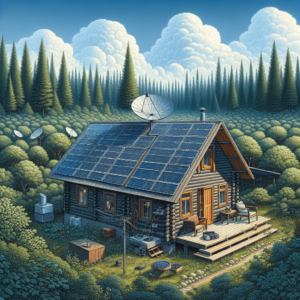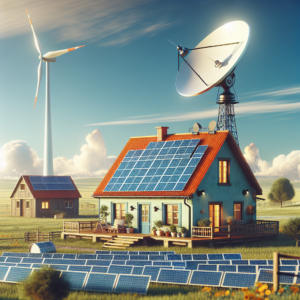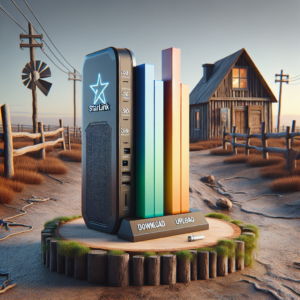
Key Takeaways
-
Assess your local climate to identify potential weather risks for your solar setup.
-
Install solar panels using sturdy mounts and strategic positioning to avoid damage.
-
Conduct regular maintenance checks to ensure your system’s resilience against the elements.
-
Protect your solar system’s components with covers and additional structural support where necessary.
-
Consider backup power solutions, like battery storage or generators, to maintain energy supply during adverse weather.
Weather-Proofing Your Outback Power Solar Setup
When it comes to harnessing the power of the sun, your Outback Power solar setup is a robust and reliable ally. But mother nature has her own plans, and sometimes they include harsh weather that can threaten your source of clean energy. To keep your system running smoothly through rain, hail, or the heat of the sun, it’s essential to take proactive steps to protect it. Let’s walk through some strategies to weather-proof your solar setup.
Evaluating Potential Weather Risks
The first step in protecting your Outback Power solar setup is understanding the weather risks unique to your area. If you live in a region with heavy snowfall, for instance, you’ll need to think about the weight of the snow on your panels. In hurricane-prone areas, the focus should be on securing panels against high winds. And in desert climates, dust and sand can be the biggest threats, potentially scratching and damaging solar cells.
Step-by-Step Weatherproofing Measures
Once you’ve identified the risks, it’s time to take action. Here’s how:
-
Secure Panel Mounting: Ensure your panels are mounted on strong, durable racks that are properly anchored. This prevents them from being lifted or shifted by strong winds or heavy snow.
-
Panel Angling: Adjust the tilt of your panels seasonally to prevent snow accumulation and to optimize sun exposure, which also helps melt away light snowfall.
-
Protective Coatings: Apply anti-reflective and hydrophobic coatings to your panels to reduce dirt buildup and make them easier to clean.

Secure Installation Practices
A solar setup is only as good as its installation. If the panels aren’t secured properly, they won’t be able to withstand the weather they’re meant to endure.
Proper Mounting Techniques
Mounting your solar panels correctly is crucial. Use heavy-duty materials and ensure that every bolt and bracket is tightly fixed. If you’re unsure about how to do this, it’s worth getting a professional to help. They’ll know how to position and secure your panels so that they’re as sturdy as possible.
-
Choose mounts that are rated for your specific panel size and weight.
-
Use locking washers and nuts to prevent loosening over time.
-
Inspect mounts regularly for any signs of wear or corrosion.
Remember, the goal is to keep your panels in place during the fiercest of storms.
Choosing the Right Location
Where you place your solar panels can make a big difference in how well they stand up to bad weather. Ideally, you want a spot that’s sunny most of the time but also sheltered from the worst of the wind and rain. If you have trees nearby, make sure to trim back any branches that could fall on your panels during a storm.
Consider the following when choosing a location:
-
Proximity to tall structures that could provide a windbreak.
-
Distance from trees or other objects that could cause shading or falling debris.
-
Orientation towards the sun to maximize energy production.
With the right location, you’ll minimize the risk of weather-related damage and ensure your system is operating at peak efficiency.
Regular Inspection Routines
Just like you’d check your car before a long road trip, regular inspections of your solar setup are a must. At least twice a year, give your system a thorough check-up. Look for any loose wires, check the integrity of the mounts, and ensure that panels are free of any damage. Catching issues early can prevent them from turning into expensive problems later on.
Performing Preventative Maintenance
Preventative maintenance goes hand in hand with inspections. It involves cleaning your panels to remove any dirt or debris that might block sunlight and reduce efficiency. If you live in an area with lots of snow, gently clear it off with a roof rake designed for solar panels. And don’t forget to check the manufacturer’s guidelines for any specific maintenance recommendations for your system.
Here are some maintenance tips to keep in mind:
-
Clean your solar panels with a soft cloth or brush and soapy water to remove any accumulated dirt.
-
Check the connections and cables for any signs of wear or damage.
-
Ensure that your battery storage system is at the correct temperature and the connections are tight and corrosion-free.

Enhancing Protection Against Extreme Elements
Your solar setup is going to face some tough days. Extreme heat, freezing temperatures, and the sheer force of nature can all pose threats. To safeguard your investment, you’ll want to enhance its protection against these elements.
Using Protective Covers and Shields
During times when the weather gets particularly rough, consider using protective covers for your solar panels. These can shield your panels from hail or heavy snow, ensuring they stay intact and functional. However, remember that covers should only be used when the panels aren’t in operation, as they block sunlight.
When considering protective measures, keep in mind: solar photovoltaic power systems for off-grid living.
-
Covers should be easy to remove so that you can quickly uncover the panels when the weather clears.
-
Ensure that the covers are made from durable materials that can withstand the specific weather challenges of your region.
-
Don’t allow covers to trap moisture against the panels, as this could cause damage over time.
Additional Support Structures for Stability
Besides protective covers, you might need additional support structures. These can range from reinforced mounting systems to wind barriers. They are particularly useful if your area is prone to high winds or heavy snow that could otherwise strain your solar panel mounts.
Consider these options for added stability:
-
Reinforced racking systems that can bear extra weight.
-
Wind deflectors that can reduce the wind load on your panels.
-
Ground or roof braces that provide extra anchorage.
Back-Up Solutions for Continuous Power
No matter how well you protect your solar setup, sometimes the weather can disrupt your power supply. That’s why having a backup plan is essential.
Here’s how to ensure you always have power:
-
Integrate a battery storage system to keep a reserve of power for when the grid goes down or your panels aren’t generating electricity.
-
Consider a backup generator, especially if you live in an area with frequent power outages. It can be a lifesaver during extended periods of bad weather.
Integrating Battery Storage Systems
Battery storage systems are like a savings account for your electricity. They store excess power generated during sunny days for use during nighttime or cloudy weather. It’s crucial to have a well-maintained battery system that’s adequately sized for your energy needs and can handle the demands of your household or business.
Setting Up a Backup Generator
Generators can provide peace of mind, knowing that you have a fallback option if your solar system stops producing power. Whether you opt for a gas, diesel, or propane generator, make sure it’s powerful enough to handle your critical loads and that you have enough fuel stored safely.
Leveraging Technology for Weather Alerts
Staying ahead of the weather is easier than ever with today’s technology. Weather monitoring systems can provide real-time data on conditions that could impact your solar setup. By integrating these systems into your solar array, you can be alerted to potential issues before they become problems.
Here’s what technology can do for you:
-
Automated weather tracking systems can adjust the tilt of your panels to minimize damage and maximize efficiency.
-
Receive alerts on your phone or computer about severe weather conditions, giving you time to implement protective measures.
-
Use data to make informed decisions about when to perform maintenance or install protective covers.
Remember, the key to protecting your Outback Power solar setup from bad weather is preparation and maintenance. By understanding the risks, taking proactive measures, and having a solid backup plan, you can ensure that your solar panels continue to provide clean, reliable power for years to come.
-
Assess your local climate to identify potential weather risks for your solar setup.
-
Install solar panels using sturdy mounts and strategic positioning to avoid damage.
-
Conduct regular maintenance checks to ensure your system’s resilience against the elements.
-
Protect your solar system’s components with covers and additional structural support where necessary.
-
Consider backup power solutions, like battery storage or generators, to maintain energy supply during adverse weather.
FAQs
As you consider the various ways to protect your solar setup, you may have some questions. Let’s address a few common inquiries:
How do snow and ice affect solar panel efficiency?
Snow and ice can significantly reduce solar panel efficiency by blocking sunlight from reaching the solar cells. However, most panels are designed to shed snow, and the angle at which they are installed can help with this. Additionally, the reflective properties of snow can sometimes increase light exposure, slightly boosting efficiency. It’s important to remove heavy snow accumulation to prevent potential damage and restore energy production.
Can solar panels withstand high winds or hail?
Quality solar panels are built to endure harsh weather, including high winds and hail. They are tested rigorously to withstand impact and pressure. However, during extreme weather events, it’s wise to have additional protective measures in place, such as reinforced mounting systems or protective covers, to provide an extra layer of defense against the elements.
What is the best angle to position solar panels for snowfall?
The best angle for positioning solar panels to combat snowfall is one that is steep enough to allow snow to slide off. This angle will vary depending on your geographical location but typically ranges from 35 to 45 degrees. Adjusting the tilt seasonally can help maximize exposure to the sun and minimize snow buildup.
How can I protect my inverter and batteries from extreme temperatures?
To protect your inverter and batteries from extreme temperatures, ensure they are installed in a location with regulated temperature, such as a garage or basement. If that’s not possible, insulate the space where they are housed and consider using temperature-controlled enclosures to maintain optimal operating conditions.
Is it necessary to have a backup generator if I have solar batteries?
While solar batteries can provide a significant buffer during power outages, having a backup generator can be beneficial, especially in areas with long periods of inclement weather or frequent power interruptions. A generator can ensure that you have a reliable power supply when your batteries are depleted and solar generation is not possible.
Protecting your Outback Power solar setup from bad weather is about being proactive and prepared. By understanding the specific risks your system faces, taking steps to mitigate them, and having backup plans in place, you can ensure that your solar panels continue to operate efficiently and safely, no matter what the skies have in store.







